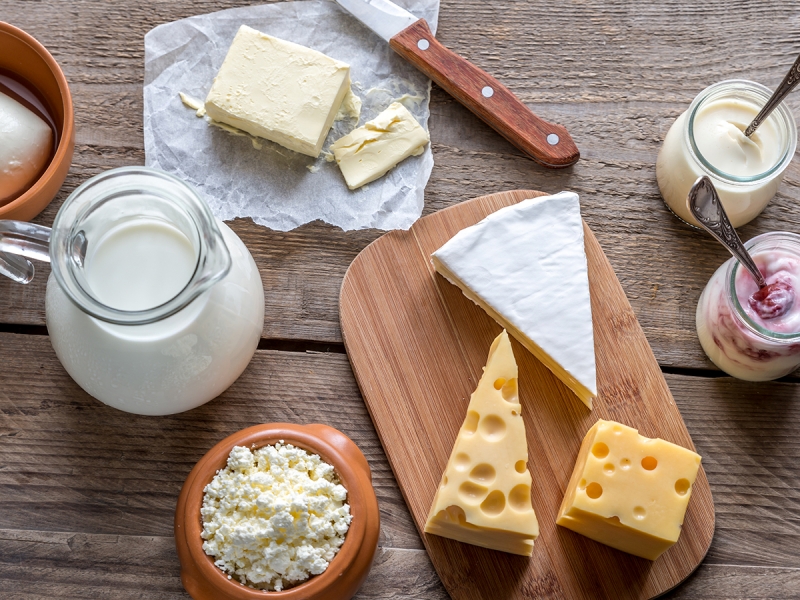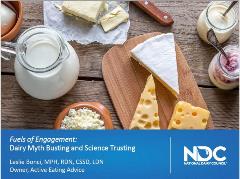Chris Cifelli, Ph.D., and Andrew Dole, MS, RDN, CSSD, CEC, USAT I |
Jan.
2, 2020

NDC and ACSM recently hosted an industry-presented webinar with Chris Cifelli, Ph.D., and Andrew Dole, MS, RDN, CSSD, CEC, USAT I, entitled Get Cultured on Fermented Dairy Foods.

Several questions were asked by attendees during the webinar and the answers pertaining to recovery, inflammation, hormones and more are below.
Q 1: Can you speak to the sugar content found in dairy products?
Lactose is the natural sugar in milk, and other dairy foods made from milk, that forms when two other sugars, glucose and galactose, join together. There are about 12 grams of natural sugar (lactose) in each 8-ounce glass of milk, which is about the same amount of natural sugar you would find in one small banana. Flavored milk, like chocolate, does contain added sugar for flavor and many flavored yogurts do, too, unless a non-caloric sweetener is used.
When looking at your diet as a whole, it is important to consider a food’s full nutrient package, including differentiating added and naturally occurring sugars in foods like milk, yogurt and fruit. Many foods and beverages with naturally occurring sugars, like milk or fruit, also contain vitamins and minerals, protein or fiber we need as part of healthy eating patterns. While milk contains natural sugar, it also provides nine essential nutrients including 8 grams of high-quality protein in every 8-ounce serving.
Government and major health organizations agree people can enjoy some sugar (both natural and added) within the recommended daily amount, especially when it comes from nutrient-rich foods such as flavored milk, sweetened yogurt or whole-grain cereals. That’s because some added sugar can improve the taste of the nutrient-rich foods many people need more of, which can mean they eat more of them. The dairy case is filled with a wide variety of dairy foods to choose from, so read the ingredient label, compare brands and pick one that meets your preferences and health needs.
Q 2: Would you say that for an individual on an elimination diet to troubleshoot some gut health issues, that person should keep yogurt in the diet rather than abstain for the 4- to 6-week duration?
If this individual is on the elimination diet under the supervision of a gastroenterologist then we’d advise continuation under their care. If not, we’d suggest the individual speak to a gastroenterologist to ensure an elimination diet is the right approach. It is important to understand the cause of gastrointestinal (GI) distress so it gets treated and essential food groups are not unnecessarily removed from the diet. Low-fat and fat-free milk provide nine essential nutrients and milk is the No. 1 food source of three of the nutrients of concern (calcium, vitamin D and potassium) in the diet of Americans. If an individual is on the elimination diet due to lactose intolerance, there are solutions that can work for many people to help them keep dairy foods in their diet. The acronym LACTOSE may help them find solutions that work for them, since lactose intolerance varies for each individual. Incorporating dairy foods into an overall balanced meal plan is important:
- Look for lactose-free cow’s milk. It is real cow’s milk with the lactose already broken down.
- Add natural, hard cheeses to your meals and snacks. Natural, hard cheeses like Cheddar, Swiss, Colby Jack and Monterey, contain minimal lactose and provide a great way to get in a serving of dairy.
- Cook with it. Using dairy in recipes is a great way to get in essential nutrients. For example, you can substitute yogurt for ingredients like mayonnaise or use lactose-free milk in baking, in hot cereals like oatmeal or in soups.
- Top veggies with it. Sprinkling a serving of grated, low-fat natural, hard cheese on your veggies adds protein, calcium and a scrumptious taste.
- Optimize your workout with dairy! Low-fat and fat-free dairy foods are a great source of high-quality protein, which may be beneficial after a workout. Mix lactose-free milk in a shake or make a parfait with yogurt, fruit and a dab of honey to replenish and rebuild!
- Scoop up a serving of yogurt. Though it contains lactose, yogurt is also full of good bacteria (e.g., live and active cultures) which helps digest the lactose and can make it easier to tolerate. Icelandic- and Greek-style yogurts have less lactose than regular yogurts and also contain the beneficial bacteria, so you may want to start with these options first.
- Experiment with regular dairy foods like milk. Introducing regular milk slowly into your diet and gradually increasing the amount over time can help your body begin to tolerate it little by little.
Before eliminating dairy foods from your diet, visit your doctor so you can be properly tested for lactose intolerance. It is possible that other GI disorders are causing your distress.
Q 3: Do dairy products contain added hormones?
A naturally occurring protein hormone in milk – bovine somatotropin (bST) – is present in cows and helps to regulate normal growth and development. Although bST is found at a very low concentration in cow’s milk, this hormone is only active in cows and is not recognized by the human body. The Food and Drug Administration approved the use of the synthetic version of this protein, called recombinant bovine somatotropin (rbST/rBGH), that dairy farmers can use to increase milk production. Even though it has gone through over two decades of testing and the U.S. Food and Drug Administration has affirmed and reaffirmed that milk from cows with rbST is safe and wholesome, it is not commonly used today. Dairy companies have responded to consumer requests for choices in the dairy aisle, and many now offer milk from cows not supplemented with rBST. This business decision is based on meeting a demand in the marketplace – it is not related to any health or safety issue.
Q 4: I’ve heard dairy is associated with inflammation, is that true?
The current scientific evidence suggests the opposite may be true. While acute inflammation is the body’s natural response to injury or infection, when we talk about dairy or any other foods in the context of inflammation, we are talking about low grade chronic inflammation which can be related to changes in the immune system. These changes can impact the body in a number of ways and are most specifically linked to serious metabolic disorders such as cardiovascular disease and Type 2 diabetes.
A growing body of research has demonstrated that adequate dairy food consumption as part of a nutrient-rich, balanced diet is associated with reduced chronic low-grade inflammation. This research was considered in the 2010 Dietary Guidelines for Americans as one possible mechanism underpinning the conclusion that “moderate evidence indicates that intake of milk and milk products is associated with a reduced risk of cardiovascular disease and type 2 diabetes and with lower blood pressure in adults.”
Though still an emerging area of research, several observational studies have shown that dietary patterns that include dairy foods (milk, cheese and yogurt) are associated with reduced non-symptomatic markers of chronic inflammation across the lifespan. To date, only a few clinical trials (the gold standard) have examined the effects of dairy foods on inflammatory responses.
Q 5: What specifically is it about chocolate milk after a workout?
Milk and chocolate milk contain important nutrients, including carbohydrate, protein, vitamins and minerals, that help people refuel and recover after a tough workout.
- Carbohydrates: Carbs fuel activity and are the No. 1 source of energy for athletes, plus they help refuel your muscles. Milk naturally contains carbohydrates and in chocolate milk additional is added via sugar.
- Protein: Having high-quality protein after a workout can help rebuild and repair your muscles. But not all proteins are equal. High-quality proteins found in foods like low-fat or fat-free milk and chocolate milk, yogurt, cheese, eggs and meats can help you get all of the essential amino acids your body needs to build and maintain your muscles and help your body work properly.
- Fluids & Electrolytes: When you work out, several minerals can be lost in your sweat including sodium, chloride and potassium. Rehydrating with milk can help replenish your body’s fluids and electrolytes lost in your sweat.
Plus you can read more here if you want to learn about other nutrients found in milk.
Presenters:

Chris Cifelli, PhD - Vice President, Nutrition Research, National Dairy Council
Dr. Cifelli oversees the Dairy and Public Health research platform for National Dairy Council (NDC). In this role, he leads NDC’s research on chronic disease risk, childhood nutrition, NHANES-related research and nutrition and sustainability.

Andrew Dole, MS, RDN, CSSD, CEC, USAT I - Owner, BodyFuelSPN
Andrew is the owner of BodyFuelSPN, a sport performance and lifestyle nutrition practice in Castle Rock, CO, specializing in endurance athletes and weight management. A certified executive chef, an active triathlete and triathlon coach, Andrew manages clients around the world, combining nutrition science, behavior modification and culinary expertise into nutrition interventions or sport performance-driven plans.
Viewpoints presented in this blog reflect opinions of the author and National Dairy Council and do not necessarily reflect positions or policies of ACSM.
Read More from the National Dairy Council

3 Surprising Benefits of Dairy for Exercise Recovery

What to Eat Before and After a Workout

Fuels of Engagement: Myth Busting and Science Trusting Webinar Q&A